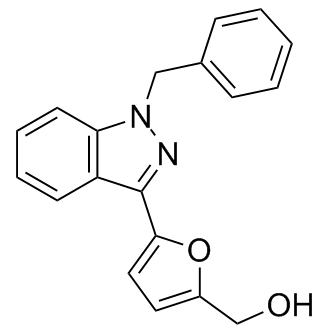| Description: |
Lificiguat binds to the β subunit of soluble guanylyl cyclase(sGC) with Kd of 0.6-1.1 μM in the presence of CO. |
| In Vivo: |
Lificiguat (YC-1) (30 or 60 mg/kg, i.p.) inhibits MDA-MB-468 tumor growth in a dose-dependent manner. The effect of the prodrug formulation of Lificiguat (YC-1), YC-1-S, in MDA-MB-468 tumor-bearing mice is also investigated. In vivo pharmacokinetic analysis reveal that YC-1-S is quickly converted into its active form. Mice are administered 20, 40 or 80 mg/kg YC-1-S p.o. YC-1-S also displays dose-dependent inhibition of MDA-MB468 tumor growth. Both Lificiguat (YC-1) and YC-1-S dose-dependently reduce tumor weight. Moreover, the mean body weight of mice is not affected by Lificiguat (YC-1) or YC-1-S compare with vehicle-treated groups[3]. Lificiguat (YC-1) is a potent NO-GC activator reported to improve rodent learning behavior when examined with the Morris water maze (MWM) and avoidance tests. Lificiguat (YC-1) enhances long-term potentiation (LTP) in hippocampal Schafer collateral-CA1 synapse via the NO-cGMP-PKG-dependent pathway and potentiated LTP induction in the amygdala, increases the activation of ERK, and potentiated the expression of brain-derived neurotrophic factor (BDNF) cAMP response element-binding protein (CREB) in response to fear memory test[4]. |
| In Vitro: |
Soluble guanylate cyclase (sGC) is a heterodimeric heme protein and the primary NO receptor. Lificiguat (YC-1) binds near or directly to the heme-containing domain of the beta subunit. In the absence of CO, Lificiguat (YC-1) binds with Kd=9-21 μM, depending on construct. In the presence of CO, these values decrease to 0.6-1.1 μM. Lificiguat (YC-1) greatly enhanced CO binding to heterodimeric sGC, as expected (Kd=1 μM). Lificiguat (YC-1) stimulates sGC two- to four-fold in the absence of NO but acts synergistically with CO or NO to achieve several hundred fold activation. Binding of Lificiguat(YC-1) can also overcome inhibitory phosphorylation of sGC[1]. Lificiguat (YC-1) is a soluble guanylyl cyclase (sGC) activator. HCC cell lines HepG2, BEL-7402 and HCCLM3 are incubated for 72 h with Sorafenib and/or Lificiguat (YC-1). Sorafenib or Lificiguat (YC-1) alone inhibits HCC cell proliferation in a dose-dependent manner. Moreover, combination of Sorafenib and Lificiguat (YC-1) significantly suppresses proliferation of HCC cells in a dose-dependent manner. In addition, at the ED50 doses for both Sorafenib and Lificiguat (YC-1), combination index values (CI)=0.93 in HepG2, 0.95 in BEL-7402 and 0.72 in HCCLM3 respectively, suggesting that Sorafenib and Lificiguat (YC-1) synergistically inhibit proliferation of HCC cells[2]. |






















